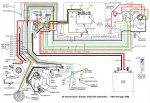MidCenturyTed
Cadet
- Joined
- May 21, 2017
- Messages
- 6
I acquired a clean appearing 64' Evinrude 40 hp electric shift motor to run on my 1960 Aluminum runabout, and having issues getting it wired properly. It came with a new marine ignition switch, and new choke switch. I did research as to how to connect all the wiring up, double checked everything and tried it out. No go, it wont turn over, and the choke isn't working properly. the choke is staying energized all the time and getting hot, and flipping the choke switch seems to de-energize it instead of energizing it. I have power at one large terminal on the starter solenoid, but none coming out the other side. Both smaller posts are hot when i turn the key switch. should they both be hot? I have checked my grounds and the motor, starter and control box are all grounded. I am mystified as to what the problem is. Wiring isn't my strong suit, but i feel like i have enough basic knowledge to do this but i'm scratching my head. Any ideas as to what i have connected improperly? It does appear that the connections have changed over the years for the ignition switch as the part number has changed for it. Could this be my issue? Any help would be much appreciated. Thanks- Ted





















